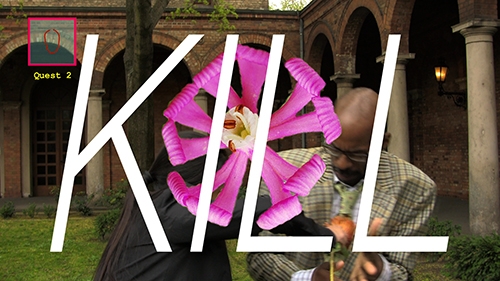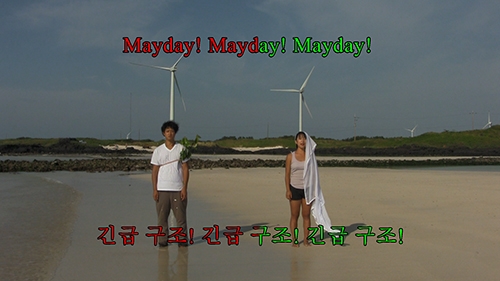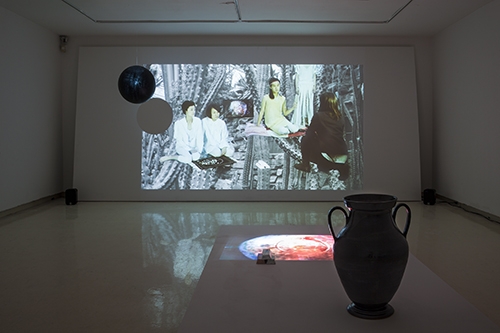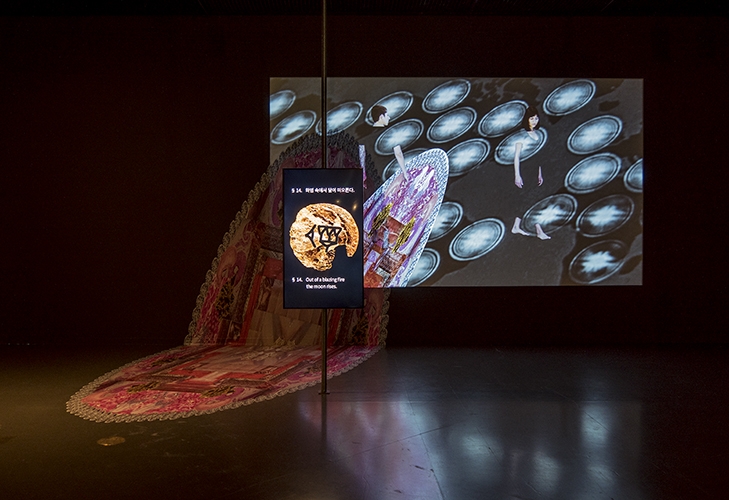레디메이드 알레고리
1
특정한 사회 문화적 체계에서 생산된 이미지와 형식적 틀을 차용한 후 거기에서 임의의 요소를 빼거나, 더하거나 이동시키거나, 대체하거나, 다른 범주의 체계와 겹침으로써 그것이 관계된 이데올로기를 다른 맥락으로 확산시키고 재의미화 하는 방식, 알레고리의 재사용은 김실비의 작업에서 발견되는 중요한 전략 중 하나다. 이는 뒤샹에서 시작하여 팝아트, 개념미술과 전유(appropriation)를 경유하는, 지난 100여 년 간의 미술사에서 가장 급진적이라고 할 수 있는 사물과 이미지의 재배치에 대한 실험의 맥락 위에 있다. 또한 디지털과 웹을 기반으로 하는 당대의 데이터베이스 미디어 환경이 세계를 구조화하는 형식이기도 하며, 이 형식은 자신의 비평적 지점을 드러내기 위해 자연스럽게 레디메이드라는 개념을 호출한다. “어떤 자료들이 어디에 분포하고 있으며 이 가운데 무엇을 선택해서 어떻게 활용할 것인가?”1 김실비의 질문은 자신의 미학적 프로그램의 구조를 결정한다.
여기서 유의해야 할 것은, 김실비 작업에서의 레디메이드 알레고리는 이중으로 작동한다는 것이다. 하나는 도상 알레고리이고, 다른 하나는 형식 알레고리이다. 도상 알레고리가 프레임 안의 의미를 재배열한다면, 형식 알레고리는 그것을 다른 형식적 틀 안으로 이동시켜 의미가 유통되는 층위를 재구축한다. 이 때문에 그의 작업은 의미의 문제이면서도 의미의 문제만일 수는 없는 기묘한 이중의 구속 상태에 처하게 된다. 모차르트의 오페라 “코지 판 투테”의 인물과 장면을 가져와 완전히 다른 서사를 덧씌워 노래방에서나 볼 수 있는 뮤직비디오로 만든 금지곡들: 여자란 다 그래(2013) 앞에서, 관객은 화면에 나타나는 가사를 따라 각자의 방식으로 노래를 읊조리게 된다. 대중 오락 문화의 프로그램을 소비하는 방식으로 우리는 작업의 변형된 알레고리를 경험한다. 여기서 알 수 있듯 레디메이드 알레고리의 집합인 김실비의 작업을 의미의 측면으로만 접근하게 된다면 그것은 나머지의 기능적 구조를 폐기시키는 일이 된다. 중요한 것은 이 전체적인 체계가 작업에 대한 경험을 어떻게 구조화시키는가이다. 때문에 김실비의 예술적 실천을 파악하기 위해서는 그가 세계를 구성하는 형식들 중에서 무엇을 선택하고 그것을 어떻게 재구축하는지를 가려내야 한다. 그리고 이를 통해 수면위로 올라오는 이데올로기의 형상을 바라보아야 한다. 이 형상은 의미로 환원되어야 할 대상이 아니라 우리에게 무언가를 요구하는 새로운 형식의 주체다.
2
육십진법에 따른 연애편지(2016), 작고 따뜻한 죽음(2016), 계시의 나날과 자매(2016)는 이중의 레디메이드 알레고리의 한 예시가 된다. 먼저 작고 따뜻한 죽음을 보자. 디지털 프린트된 이 거대한 이미지는 한스 홀바인의 저 유명한 대사들(1533)에서 메멘토 모리(Memento Mori)의 상징과도 같은 해골 모양을 본 딴 듯 바닥과 벽에 걸쳐 왜상(anamorphosis)으로 설치되어 있다. 불교미술의 한 형식인 만다라를 차용한 둥근 프레임 안에는 종교적 상징을 대체하여 죽은 동물의 내장 기관과 살(flesh)의 해부학적 이미지가 구성적으로 배치되어 있다. 육십진법에 따른 연애편지의 전경에는 재사용된 영상 이미지가 끊임없이 흐르고, 화면 가운데에는 고대 바빌로니아에서 사용했던 60진법의 기호가 이어진다. 60진법은 현대사회에서 더 이상 보편적으로 사용하지 않는 수 체계이지만, 그 어떤 이데올로기보다 강력하게 현재적 삶을 구속하는 계량화된 시간, 산업 사회의 행동양식을 성립시킨다. 계시의 나날과 자매는 두 명의 연기자가 등장하여 서사라기보다는 그 자체로 알레고리인 연출된 행위와 대화를 드라마로 보여주고, 그린스크린 처리를 한 인물의 몸 위로는 끊임없이 파운드 푸티지가 흐른다. 이 영상의 출처는 두 개인데, 하나는 웹 아카이브에서 찾은 역사적 자료 영상이고 다른 하는 디지털 합성 소스 사이트에서 제공하는 샘플 영상이다.2 세 작업은 각각이 무수히 많은 알레고리의 집합으로 이루어져 있으면서도, 전시장 안에서 물리적으로 긴밀히 연동된다. 변형된 만다라 도상은 계시의 나날과 자매가 영사된 프레임의 모서리에 간섭하면서 또 동시에 음화화 된 화면에 홀연히 나타났다 사라지고, 디지털 영상의 포맷인 16:9 화면비로 제작된 계시의 나날과 자매와 9:16 비율로 회전된 육십진법에 따른 연애편지는 관람의 동선에 따라 중첩되어 보이도록 설치되었다. 공간 안에서 이들은 필연적으로 서로에게 개입한다. 더 정확하게 표현하자면 경계를 지우며 상호 침투하고 확산된다. 이러한 특성으로 인해 세 작업은 한 평면 위에서 중첩될 가능성과 개별적으로 흩어져 분산될 가능성을 동시에 내포하는데, 전시장이라는 공간은 이 상태를 관람의 경험으로 구조화하는 매체로 기능한다.
개념미술의 작가들이 유통의 방식을 예술의 주제, 비평적 지점으로 삼기 위해 전시장이 아닌 대안적 공간을 끊임없이 발명했다면, 김실비는 전시장 그 자체를 형식 알레고리로 재전유한다. 개인전 엇갈린 신(들)(2015)에서의 전시장과 에밀리 D.: 미분화 상태의 협업(2012), 레르스타와 관련자들(2017)과 같은 작업들도 이러한 맥락으로 읽을 수 있는 예일 것이다. 전시장은 공간화된 재현이며, 그러한 전시장이 구조화하는 경험이란 마이클 프리드가 “연극성”이라고 폄하한, 여러 범주들 사이의 틈새를 유동적으로 오가는 그런 운동성일 것이다. 때문에 김실비의 작업이 형식화한 전시장은 일종의 데이터베이스와 유사한 모습이 된다. 거의 무한대에 가까운 정보가 집적된 세계에 대응하는 문화적 재현 형식으로, 집합의 항목을 검색하고, 보고, 필터링하거나 합성하는 것이 가능한 장소 말이다. 어빈 파노프스키가 선원근법을 근대의 상징적 형식으로 보았다면, 마노비치는 “컴퓨터 시대의 새로운 상징적 형식, 즉 우리 자신과 세계에 대한 경험을 구조화하는 새로운 방식”으로서 ‘데이터베이스’를 전면에 내세운다.3 앞서 살펴보았던 것처럼, 김실비가 만드는 전시장은 그 자체로 집적된 항목들이 중첩되고 섞여 들어가는 임시적인 상태를 창출한다. 즉 그는 전시장이라는 형식틀을 통해 데이터베이스가 경험과 지각을 구조화하는 방식을 가시화한다. 때문에 작업이 배치된 공간에서 모든 알레고리와 알레고리의 사용에 대해 해석학적으로 접근하는 것은, 사실상 불가능할뿐더러, 작업의 운동성과는 다른 결에 있다. 해석학적으로 접근한다 하더라도 집중해야 할 곳은 알레고리 자체가 아니라 알레고리가 운용되는 비가시적인 장소이다. 파노프스키는 “개개의 예술상의 시대나 지역이 원근법을 지니고 있는가의 여부만이 아니라 그것이 어떠한 원근법을 지니고 있는가라는 것이 이들 시대나 지역에게 본질적인 중요성을 갖는다”4라고 말하는데, 김실비의 작업이 본질적인 중요성을 갖게 되는 것은 전시장이 하나의 형식적 틀이 될 때이다.
3
앞서 금지곡들: 여자란 다 그래의 짧은 뮤직비디오들은 노래방 화면의 형식을 차용한 것인데, 이처럼 다른 장르 혹은 다른 체계가 작동하는 관습적인 문법을 형식적 틀로 가져와 사용하는 것은 김실비의 작업이 스스로의 위치를 유동적인 것으로 바꾸는 중요한 요소다. 장르의 경계를 침범하며 특히 그가 즐겨 사용하는 것은 일종의 서사형식이다. 총 세 개의 장으로 이루어진 목석과 당나귀의 전개에서 눈에 띄는 것은 첫 번째 장과 두 번째 장 사이, 세 번째 장이 끝난 후에 틈입해있는 푸티지다. 교회, 시위의 장소, 궁전과 놀이터, 도서관, 극장, 아고라, 인기가요의 방송용 무대, 절이 맥락 없이 이어지지만 이들은 묘하게 하나의 위상으로 겹쳐 들어간다. 이것이 전체적인 주제를 암시하는 도상 알레고리라면, 아버지가 암살당한 주인공과 세 명의 선지자(장님과 벙어리, 암살자)등 장르 서사에서 볼 법한 인물들은 주제를 형용하는 또 다른 알레고리처럼 보인다. 목석과 당나귀는 무협 영화의 서사 형식과 비디오 게임의 서사 전개 구조를 차용한다. 게임의 진행을 위해 필요한 숨겨진 알고리즘은 점철된 알레고리를 맥락화하는 데 이용되고, 관객은 이 알고리즘에 따라 서사를 비위계적인 방식으로 구조화하게 된다. 여기서 비위계적 서사라는 것이 김실비 작업이 지니는 특이점이다. 마노비치에 따르면 인과성을 만드는 서사라는 형식과 순서가 매겨지지 않은 목록의 데이터베이스라는 형식은 자연스럽게 서로 대립된다.5 그러나 김실비 작업에서 서사는 위계적 인과를 만드는 인터페이스로 사용된 것이라기보다는, 집적된 알레고리의 항목들을 유통시키는 임시적인 경로, 비틀린 픽션으로 보다 기능적인 것에 가깝다. 즉 그의 작업에서 서사는 그 자체로 독립된 알레고리이기에 집적된 알레고리와 대립하거나 그것을 부연하지 않고 상호적이다. 이러한 전략이 흥미로운 이유는 우리가 자리한 세계에서 이데올로기를 순환시키는 형식을 끊임없이 발견하고 되가져온다는 데 있다. 관객은 바로 그러한 방식으로 경험을 구조화하게 되지만, 레디메이드의 급진성이 그러하듯, 그것은 기존의 자리와는 전혀 다른 차원에서 유통된다. 중요한 것은 작업이 기능하는 방식 그 자체이고 이를 통해 촉구되는 새로운 합의이다.
4
레디메이드가 자기 자신의 체계를 현전시키는 유효한 수단이라고 했을 때, 그것의 근본적인 욕망은 무엇인가? 실제적인 물질과 상태를 이용하여 비가시적인 이데올로기를 끌어들이기 위해 대안적 시공간을 만드는 전략, 레디메이드의 가장 핵심적인 가치는 대상을 명료하게 지시하기 위한 시도를 허위로 만들면서 그것을 둘러싼 체계 자체로 논의를 환원시킨다는 데 있다. 여기서 중요한 것은 체계의 형상을 드러내기 위해 반드시 체계의 요소를 경유한다는 사실이다. 외부자의 위치에서 수행하는 비판은 진정한 비판이라기보다는 해석에 가까운 것이며, 세상에 대한 고발이나 비평을 위해서는 먼저 자기 자신이 비평하고자 하는 형식 내부에 있어야만 한다는 니꼴라 부리요의 말은 비평 형식으로서의 미술을 위한 조건이기도 하다.6 또한 세계는 끊임없이 변하기 때문에 규범적인 비판은 유효하지 않을 때가 많다. 고전적 아방가르드가 스스로를 사회적 형식에서 소외시킴으로써 충격을 주었다면, 유동성을 무기로 삼는 동시대 자본주의와 상업 미디어 속에서 새로운 아방가르드는 그것의 형식을 껍데기로 빌려 입고 체계 안으로 스며들어 전복적이기를 기도한다. 이데올로기 안의 형식을 재사용하는 것은 그것의 소요를 통해 이데올로기의 재배치를 실험하는 것으로, 실재성을 발판삼아 체계의 외연과 맞닿는 통로를 확보하는 일이다. 이러한 맥락에서 김실비의 작업은 작가적 문제의식이 반영되고 표현된 결과물이라기보다는 새로운 체계를 짜 보기 위한 실험의 영역에 가깝다. 작가의 욕망과 작품의 욕망은 서로 다른 운동성을 지닌다.
1
Appropriate images and forms produced within particular social and cultural systems. From there, arbitrary elements can be subtracted, added, shifted, replaced or even superimposed to systems of different categories. In this way, the ideology to which images and forms are related can be dispersed and redefined in another context. In other words, an allegory can be re-used – and I perceive this re-use of allegories to be one of the key strategies found in Sylbee Kim’s work. The strategy can be inferred from a strand of experiments in rearranging objects and images, which could be called to have been one of the most radical practices over the past hundred years of art history, starting with Marcel Duchamp and continuing on through pop art, conceptual art and appropriation. It is also a format through which digital and web data-based contemporary media environment structures the world. It is a format that naturally invokes the notion of “readymade,” aiming to expose its own critical standpoint. As an artist, what interests Kim is “observing which digital artifacts become settled in particular places and how they are accumulated, then deciding what to select and how to use it.”1 And it is this questioning that configures the structure of her aesthetic program.
One remarkable point here is the twofold way in which readymade allegory operates in Kim’s work, namely the iconographic allegory and the formalistic allegory. Iconographic allegory concerns the rearrangement of meaning conveyed in a framed image, whereas formalistic allegory displaces it into another formal frame to restructure the layers where the actual meaning is circulated. As a result, Kim’s work is faced with a double bind, posing a question around meaning and not ceasing at the questioning of the meaning per se. In Kim’s Banned Songs: Così Fan Tutte (2013), characters and scenes from Mozart’s opera Così fan tutte (1790) are transposed to an entirely different narrative via music videos that look like a karaoke background. Viewers can internally ‘sing along’ in one way or another the mute lyrics that rhythmically flow on the screen. We experience mutated allegories in the work in the same manner we consume popular entertainment programs. In this sense, Kim’s work is a collection of readymade allegories and thus, approaching it solely through the elements related to its meanings would indicate to discard the functional structure of the rest. The focal question would be then how the work’s generic system structuralizes the actual experience of the work. Understanding Kim’s form of artistic practice requires us to determine what she chose among the forms that construct the world and how she reconstructs them. We must also look at how ideologies come into visible shapes through this process. These shapes are not subject to be reduced to certain meanings, but instead they are subjects of a new form that actively demands our engagement.
2
Kim’s recent installation consisting of A Sexagesimal Love Letter (2016), A Little Warm Death (2016) and Sisters in the Plutocratic Universe (2016) are examples of dual readymade allegories. A Little Warm Death is a massive and digitally processed print image, an anamorphic installation that crosses through the floor and crawls onto the wall. It reminisces the motif of skull, the memento mori in Hans Holbein’s acclaimed painting The Ambassadors (1533). Within the round frame adapted from the style of Buddhist mandala, religious symbols are replaced by a compositional arrangement of anatomical images showing the internal organs and flesh of dead animals. The foreground of A Sexagesimal Love Letter consists of appropriated video images in continuous flow, while in the center of the frame a series of ancient Babylonian characters indicating sexagesimal numbers is presented. As a numeral system, sexagesimal is no longer widely used, yet it still establishes the quantified time, a form of behavioral patterns in industrialized society that encompasses contemporary life more powerfully than any other ideology. Sisters in the Plutocratic Universe shows two performers enacting a choreographed performance in dialogue that is itself an allegory rather than representing any kind of narrative; at the same time, their bodies are green-screened to create a negative space where the found footages are flowed. The images are historical material and samples of digital compositing from open web archives or platforms.2 Each of the three works is a full of numerous allegories, while the three interact closely within the physicality of the exhibition space. The obliquely distorted icon of mandala interferes to a corner of Sisters’ projection, and switches quickly between the visible and the invisible under the skin of negative bodies projected over it. Sisters was shot in the 16:9 ratio of digital moving image while Love Letter is rotated to have a proportion of 9:16. Depending on the movement and the standpoint of the viewer, the two channels overlap in different degrees, inevitably interfering to each other in the actual space. More precisely, they erase boundaries to permeate one another and disperse. Due to this aspect, in the three works both possibilties of overlapping over a same surface or of dispersing as individual elements are latent. Here, the exhibition space turns into a medium that articulates this dual state into a viewing experience.
Whereas Conceptual Art artists historically perceived the formats of distribution as their artistic subject matter and criticality and engaged with inventing alternative spaces beyond the exhibition space, Kim re-appropriates the exhibition space itself as a formalistic allegory. Kim’s solo exhibition Misread Gods (2015) as well as previous works such as Emily D.: The Latent Collaboration (2012) and Lersta and Her Relatives (2017) are good examples of this approach. An exhibition space is a spatialized representation and the experiences structured by those spaces may correspond to a dynamic that Michael Fried once described with the pejorative term of “theatricality,” which fluidly roams over the ruptures between categories. As a result, the formalized exhibition space where Kim’s work intervenes comes to resemble a database – a form of cultural representation in response to a world in which nearly infinite amounts of information have been accumulated; a place where it is possible to search through, view, filter, and compose the collected entities. Erwin Panofsky saw linear perspective as symbolic form of the modernity, while Lev Manovich emphasized database as “a new symbolic form of a computer age or a new way to structure our experience of ourselves and of the world.”3 As noted above, Kim’s intervened exhibition spaces themselves result into a temporary state in which collected entities are overlaid and merged together. In other words, Kim employs the formalistic frameset of the exhibition space to visualize the mechanisms relying on which databases structuralize our experience and perception. Thus attempting to decipher every single allegory in this space of arranged allegories is in fact impossible and falls in a different vein from the dynamic of her practice. Even through an interpretative analysis, the reading shouldn’t focus on allegory itself, but on the invisibility of where the allegory is situated. As Panofsky wrote, it is essential “to ask of artistic periods and regions not only whether they have perspective, but also which perspective they have.”4 The essential significance of Kim’s work arises, when her exhibition space is transformed into a formalistic framework of its own.
3
The short music videos of previously mentioned Banned Songs: Così Fan Tutte appropriate the form of karaoke background videos. Importing conventional grammar of disparate genres or systems and applying them to the formalistic framework is an important element in Kim’s work, by means of which she positions it into a state of fluidity. Trespassing different genres, Kim especially favors the narrative strategy. What we notice in Stone and Donkeys (2014), a work in three chapters, are inserts that appear before the second chapter and after the third chapter. There, we see a church, a site of demonstration, a mosque, a playground, a library, a theater, an agora, a pop music television stage and a temple. This loose chain of sites yet swirls toward a curiously singular coordinate. While this appears as an iconographic allegory suggesting a possible theme, the characters such as the protagonist whose father has been assassinated and the three prophets (the blind, the deaf and the assassin) seemingly derive from specific narrative genres and indicate another type of allegory that equally articulates the theme. Stone and Donkeys draws on the narrative style of martial arts movies and the narrative development of a video game. The intrinsic algorithm for the development of different stages in a game are utilized to contextualize the intertwined allegories in the work, while the viewers can recognize the algorithm to structuralize the narrative in a non-linear way. From this non-linear narrative sprouts the singularity of Kim’s work. According to Manovich, a mutual opposition occurs naturally between the narrative form relying on cause and effect and the database form consisting of lists that lack of any order.5 In Kim’s work, however, narrative is less an interface for creating linear cause and effect, but it is rather functional, working as a temporary channel for circulating accumulated allegorical entities or even as distorted fiction. In other words, because the narrative in Kim’s work is itself an independent allegory, it is conjunctive to the accumulated allegories and not conflictive or subordinated to it. What makes this strategy so interesting is the way Kim is constantly discovering and retrieving forms that circulate ideology inside the world we dwell. Viewers can use this very method to structuralize their experience, but analogous to the radicalism of readymade, it gets circulated on an entirely different dimension from its initial place. In the end, what matters there is the methodology itself how a work can function, and the new common that arises through this process of reconsideration.
4
If the readymade were an effective means of presenting its own system, what could be its principal desire? Readymade is a strategy of creating alternative time and space through employing actual material and states to involve invisible ideologies. And its core value lies in the failed attempts to clearly indicate the object, while directing the discussion to the actual system surrounding the object. Yet the crucial fact here is that to reveal the shape of the system, we are destined to navigate through the elements that originated from the system. Nicolas Bourriaud once stated that criticism from an outsider’s perspective is closer to interpretation than true criticism, and that if one wishes to indict or criticize the world, one must first inhabit the form of what one wants to criticize.6 This condition also applies to art as a critical form. Moreover, the world never ceases to change and even seemingly the most normative criticism may quickly lose its validity. Classical avant-garde awakened the society through alienating itself from socially reckoned forms. The new avant-garde, situated under the influence of contemporary capitalism armed with liquidity as well as of commercial media, disguises itself as part of the system to penetrate and subvert it. Repurposing forms predefined by ideology means to experiment with the rearrangement of ideology through cost form itself. Thus the artwork can secure the channels that lead us to the system’s extensity on the grounds of our presence. In that sense, Kim’s work is less a reflection and expression of an artist’s critical awareness, but it is more approximate to experiments to weave together a new system. In other words, the artist’s desire and that of her work rightly orient toward diverging dynamics.
-
이단지, 전시를 앞둔 인터뷰, 엇갈린 신(들) 전시 도록, 인사미술공간, 8쪽.
Lee, Danji, “An Interview prior to the Exhibition,” Misread Gods exhibition reader, Insa Art Sace, 2015, p. 13. ↩ ↩ -
“MONTHLY REVIEW # 01 : 작가 김실비를 만나다” “Monthly Review #1: Interview with Sylbee Kim,” link ↩ ↩
-
레프 마노비치, 서정신 역, 뉴미디어의 언어, 커뮤니케이션 북스, 2014, 290-295쪽.
Lev Manovich, The Language of New Media, MIT Press, 2002. ↩ ↩ -
에르빈 파노프스키, 심철민 역, 상징형식으로서의 원근법, 도서출판 b, 2014, 27쪽.
Erwin Panofsky, Perspective as Symbolic Form, MIT Press, 1996. ↩ ↩ -
니꼴라 부리요, 손부경 외 1인 옮김, 포스트프로덕션, 그레파이트온핑크, 107쪽.
Nicolas Bourriaud, Postproduction, Sternberg Press, 2005 ↩ ↩



